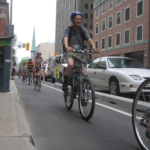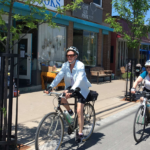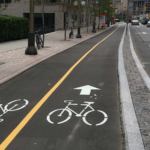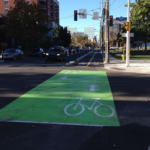Canada / Cycling / Developments / Infrastructure / Public Spaces
Ottawa, Canada creates cycling space by removing car lanes
While Montreal and Vancouver often receive the attention of cycling pundits, Ottawa, Canada’s capital, is quietly chipping away at the abundance of car traffic lanes in and around downtown.
Over the last ten years, Ottawa’s city council and its citizens increasingly expressed the desire for a more livable city, to enjoy the waterfront, the greenspace and the many historic buildings. What better way to enjoy Ottawa’s young but rich history than exploring it by bike or by foot?
Mobycon has been following these progressive developments in the capital after being introduced to Canada by the Dutch embassy around eight years ago. Today Mobycon has an office in this exciting outdoorsy city of about a million people.
Watershed moment
The watershed moment was in 2011, when Laurier Ave in downtown became part of the cross town cycling corridor. The four lanes were reduced to two lanes and curbs were put in place to separate cyclists from car traffic. The makeover pilot was an instant hit and the number of bike rides increased by around 300%. Two years later the project was declared a success: the bike lanes stayed, counting close to half a million rides each year.

Main Street
Main Street, another four lane arterial, was upgraded to a complete street in 2017, losing two car lanes and gaining raised bike lanes. A large development on the former 26-acre lands of the Oblate Fathers, currently being developed, will bring many more people to Main Street. The expectation is that retail will increase in this street in Old Ottawa East.
Street food vendor Sula Wok moved already into a new building on Main Street. Co-owner Andrew is excited about the 21 million dollars foot and bicycle bridge over the Rideau Canal that will bring the residents from nearby upscale Glebe neighbourhood much closer to his restaurant.

Main Street is a perfect example of how a complete street makes an entire neighbourhood more desirable, attracting higher end developments and creating a considerably increased tax base.
US Embassy
Mackenzie Ave runs in front of the American embassy; it used to have three southbound lanes. After 9/11, one lane in front of the embassy was ‘sacrificed’ to put up unsightly Jersey barriers as an extra protective concrete barrier. US ambassador Bruce Heyman eventually suggested to convert the lost space into a bidirectional bike lane. Local authorities and the US Embassy chipped in: the barriers were removed and replaced by much more attractive bollards, protecting both the embassy and residents who bike.

O’Connor Ave
City research showed that southbound O’Connor Ave with three lanes was bigger than needed. The road forms an ideal connector with a brand new mixed-use development about 3 km south of Parliament Hill. Ottawa turned the east lane into a bidirectional bike lane between the Glebe and downtown. The next step is connecting the O’Connor bike lanes to Wellington St. In the very near future Wellington St will also have bike lanes in front of Parliament Hill, right underneath the Prime Minister’s office windows.

These are only a few examples where residents are taking back the streets. It turns out that motorized traffic delays are minimal; meanwhile the gain for local street life is a big win.
Mobycon Ottawa
It might not come as a surprise that with all those exciting developments, Mobycon chose Ottawa for its North American headquarters and had a hand in a number of the designs for the infrastructure described above. Let’s face it: nothing beats living and working in such an inspiring environment!

